
Japanese gardens can be divided into two basic types, Sacred and Secular.
# Sacred gardens tend to be more austere, with rock and gravel gardens being usually associated with temples, shrines or palaces dedicated to spiritual entities. They are created as places of mediation and contemplation.
# Secular gardens in most cases have been created for entertainment and enjoyment. They tend to be landscaped, wonderful to look at and walk through, with hills (either natural or man-made), ponds, streams and waterfalls. Plants and decorative elements are carefully placed around the garden for the enjoyment of visitors
Whether they are small Stone and Sand gardens often found near temples or larger landscaped gardens Japanese gardens all have a spiritual quality to them and leave the visitor with a sense of peace and tranquillity.
Unlike many western gardens there are no straight lines, formal flower-beds or geometric shapes. In Japanese gardens features of great age are revered and voids are as important as solids.
Japanese Gardens - a brief history:
Early Japanese garden design was influenced by the Koreans and Chinese. During the Asuku Period (538- 645AD) Buddhism was brought to Japan from Korea. Gravelled courtyards were created as part of the Temple complex. The only surviving temple from this time is Horyu-ji Temple, 12km from Nara.
In the following years (645-710AD) Hakuko Period there was much more influence from China, during this time the Temples still had gravelled courtyards.
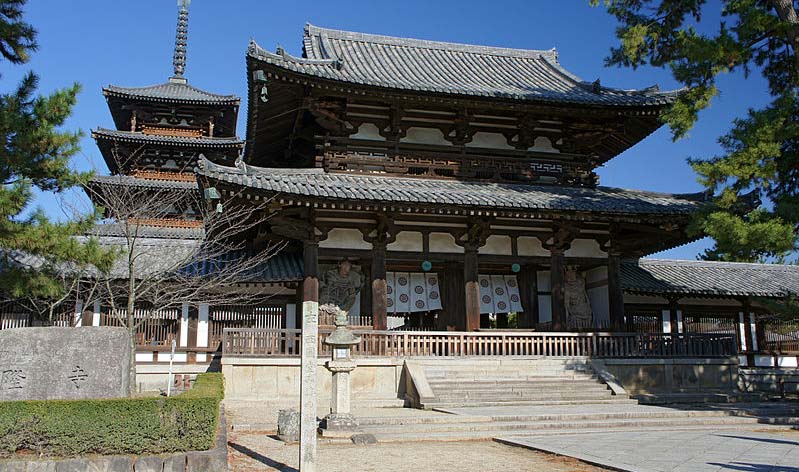
Horyu-ji Temple complex – photo 663Highland
The Nara period from 710-794 AD was a high point of Buddhism in Japan, it was time of growth in the arts and architecture. Towards the end of this period and into the next Heinan period (794-1185) we can see further influence from China with the construction of Shinden Style Mansions and Gardens built for the aristocracy and imperial family.
The House would have a large open space at the front this would be used for various ceremonies and events. The garden would be built around a pond, in the south of the lake would be one or more islands, an arched bridge link the island to the garden. These landscaped pond gardens were known as Paradise Gardens and visitors would enjoy boating on the pond.
The paradise garden of the Enjo-ji Temple is one the only examples of a garden from the period.
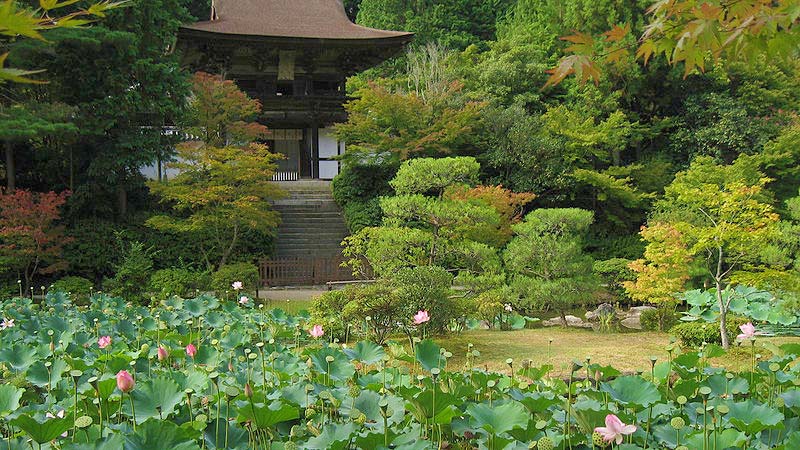
Enjo-ji Garden – photo by Hamachidori
During the Kamakura Period (1185-1133 AD) Japanese society had become feudal, the shogun was head and governed by the ways of the warrior. It was during this time that Zen Buddhism was introduced from China and quickly received a following amongst the Samurai and War Lords. During this time the Paradise Gardens became Stroll Gardens evolving into more contemplative gardens to be viewed from the temple and resembling Chinese Gardens of the period.
The Muromach Period (1333-1573) was a time of great development of Japanese arts and garden design. During this time the Shogun moved back to Kyoto and many wonderful temples and gardens were built.
The stroll gardens were still an important part of the temple garden but at this time an new garden was added to the temple garden design, the Karesanui or dry landscaped garden. This style of garden was based on Zen ideology the aim to imitate nature and act as an aid to meditation.
The main elements of these gardens are rocks (representing land features) and gravel (water). Often the only plant life is the moss growing on the rocks. The gardens tend to be surrounded by a wall and only viewable from the porch of the chief monks house.
Examples of these temples include Ryoan-ji, Tenryu-ji, Kinkaku-ji (Golden Pavillion) and Ginkaku-ji (Silver Temple)
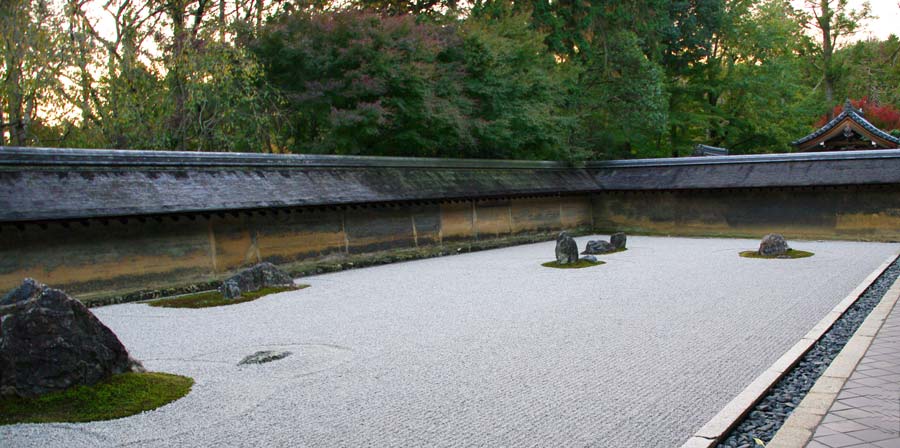
Dry Landscaped garden (karesanui) – Ryoan-ji
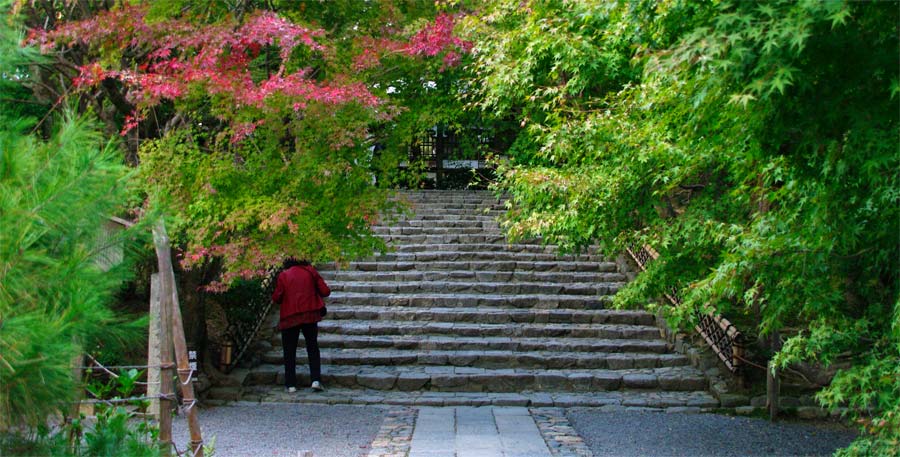
Landscaped garden – Ryoan-ji
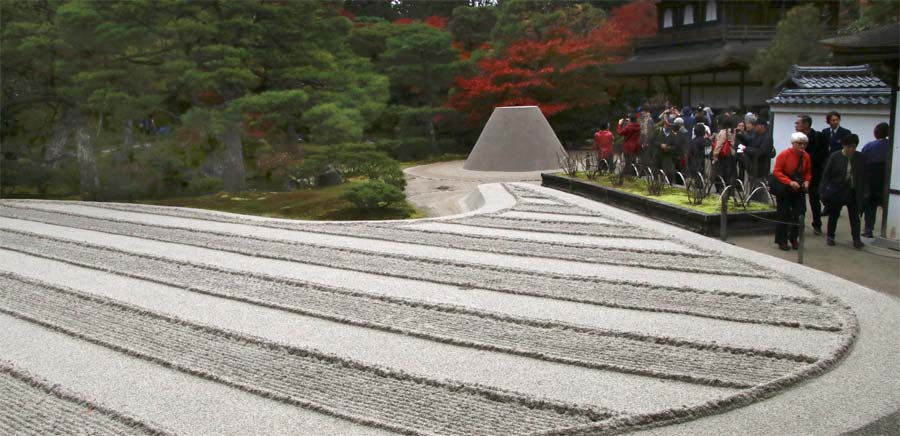
Gingkaku - dry garden
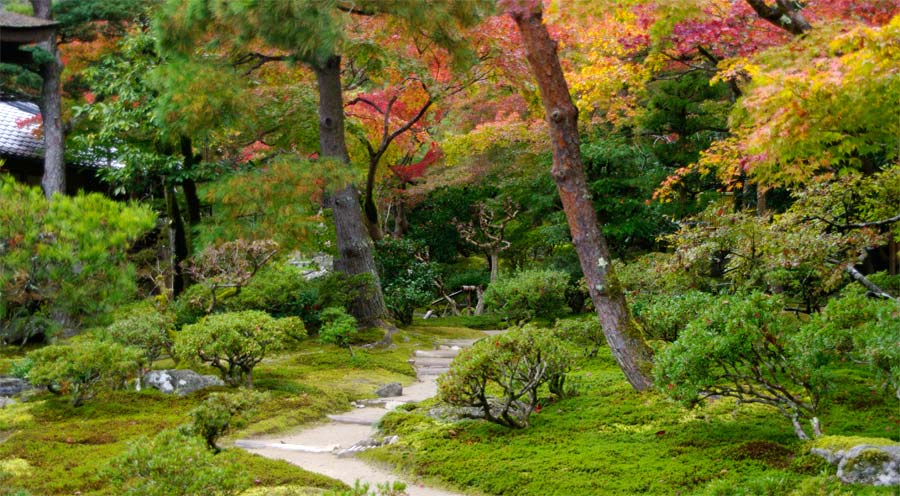
Gingkaku - landscaped gardens
Tea Houses: In the 14th century the tea ceremony was introduced into the garden and small simple huts were built, this was spiritual rather than social. Stepping stones would lead guests towards the tea house, along the way would be placed decorative elements, lanterns and waterbasins. Within the garden of Urakuen in Inuyama is one of the oldest and finest surviving teahouses.
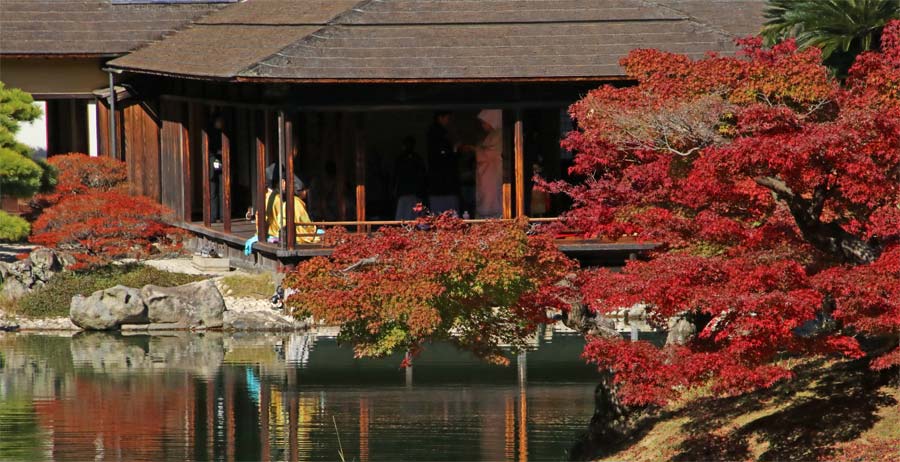 A beautiful Tea House on the shores of the lake – Ritsurin Garden
A beautiful Tea House on the shores of the lake – Ritsurin Garden
The Momoyama Period (1573-1600) represents a short period of 27 years when the reunited Japan governed by a series of three military leaders. This was a time when showing strength was important – ponds tended to be more complex and large rocks were used to indicate power and authority.
Two examples of these gardens are Shosien Garden andd Ni-jo Castle Garden both in Kyoto
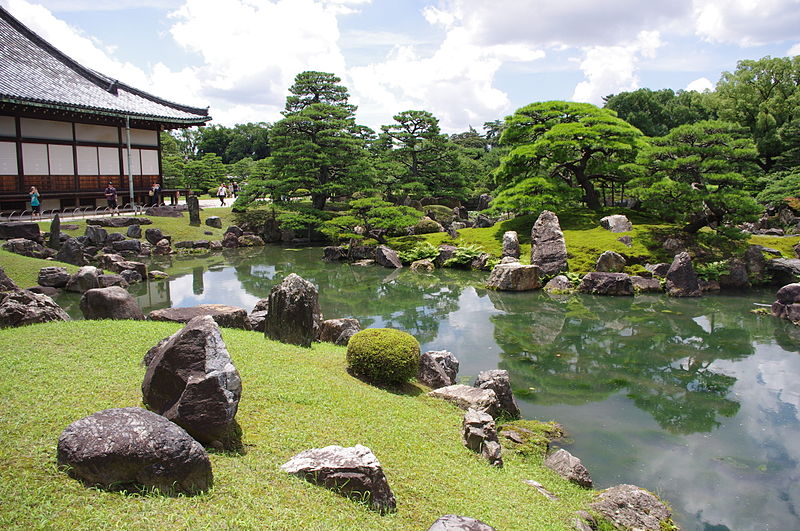
The garden of Ni-jo Castle – photo by Jakub Halun
The Edo period (1603-1865) is a peaceful and stable time in Japan also noted by its isolation from the west. The garden design reflects this time of peace; the gardens become larger incorporating lakes, islands, bridges and paths for visitors to stroll the gardens.
The large stroll gardens were designed to control the views and borrow vistas from the countryside or buildings nearby. The aim to create a constantly changing landscape full of interesting features.
Good examples of these include Ritsurin, Korakuen and Isuien Gardens.
It is interesting that principles and ideas are the same as those developing in Europe at the same time, however it is believed that each developed in isolation from the other.
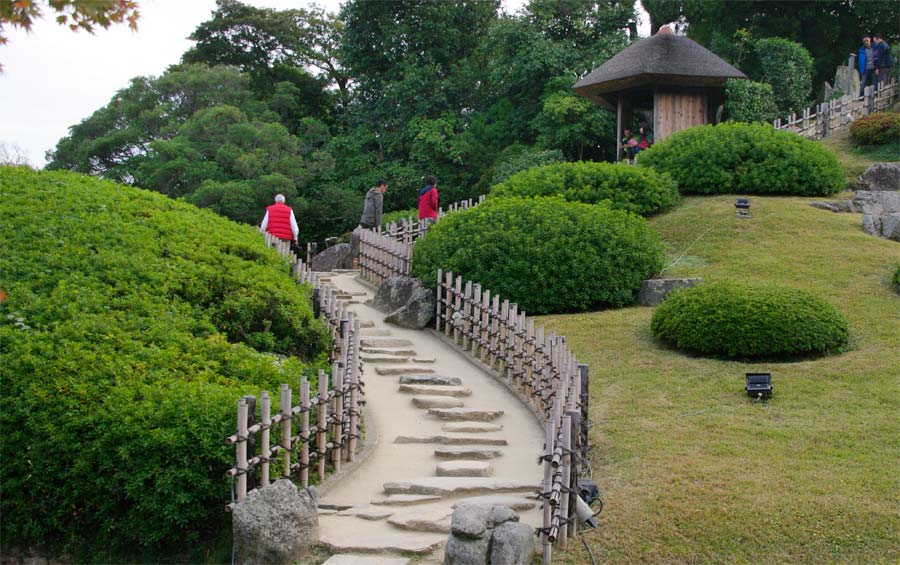
Visitors can stroll along the many winding paths - Korakuen Gardens
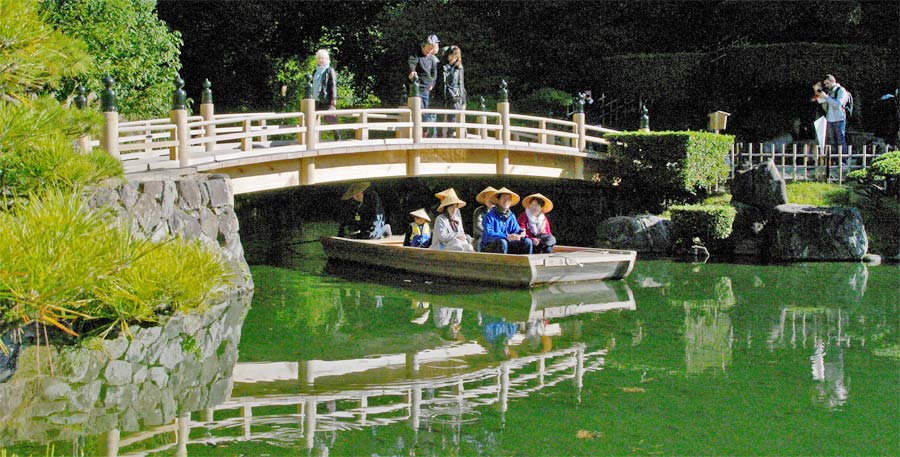
Guests were invited to view the garden from the lakes - Ritsurin Gardens
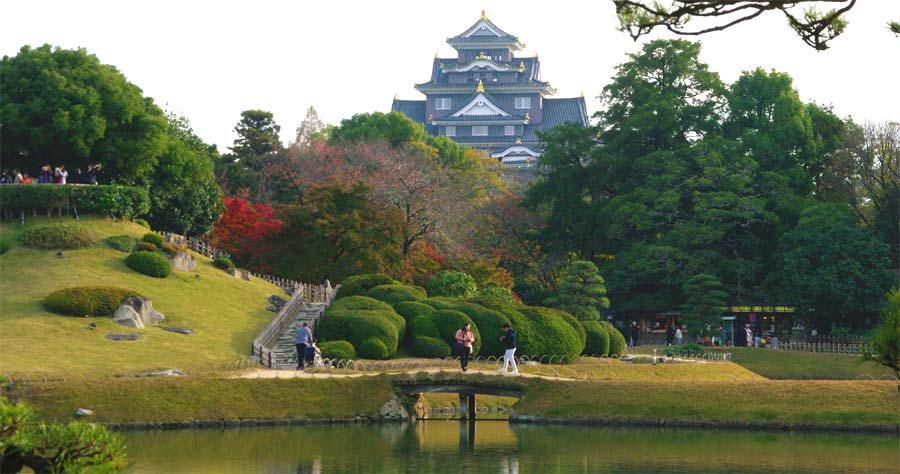
Landscaped gardens with artificial hills, streams, lakes and borrowed view of Okayama Castle – Korakuen Gardens
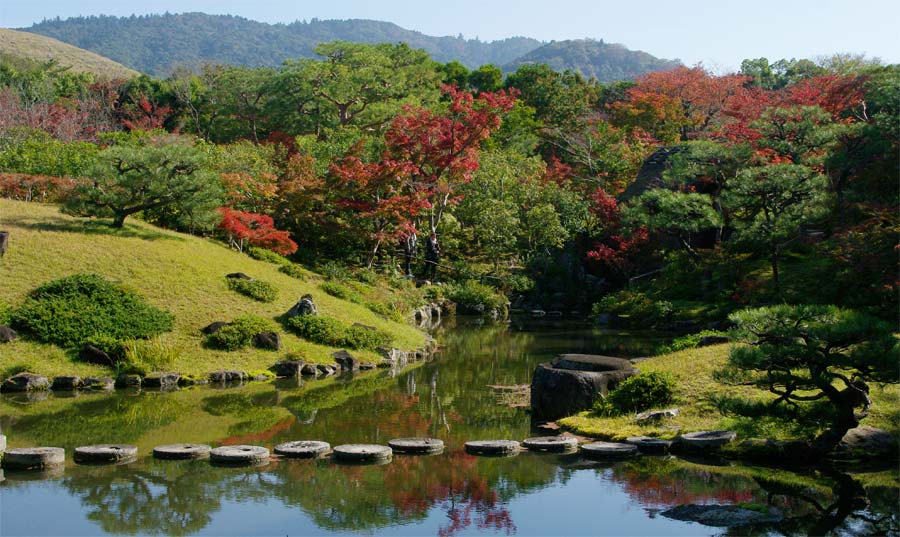 Broad landscaped gardens with borrowed view of the three cherished hills in the distance – Isuien Garden
Broad landscaped gardens with borrowed view of the three cherished hills in the distance – Isuien Garden
After the years of isolation during the Edo period, the Meiji period (1868-1912) was a time when Japan embraced western influences. It was also a time of modernisation, militarisation. The Samurai class and Shogunate were abolished, the Emperor reinstated and Japan became a constitutional monarchy. We see in gardens of this time the creation of formal rose beds.
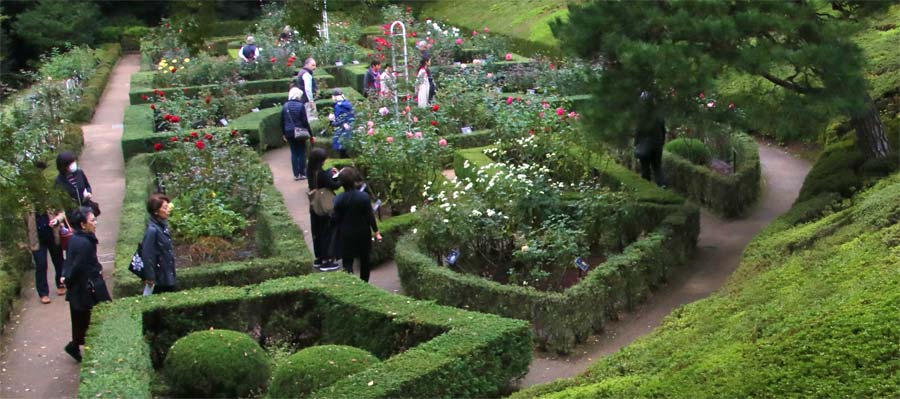
The Rose Garden at Kyu-Furukawa
Elements to look for in a Japanese Garden:
Rocks – used in many ways in gardens. They can symbolise mountains, rugged sea scapes. Smooth rocks are often used as stepping stones. Rocks are classified by shape and arranged in groups of 2, 3 5, or 7 of these groups of 3 is the most common
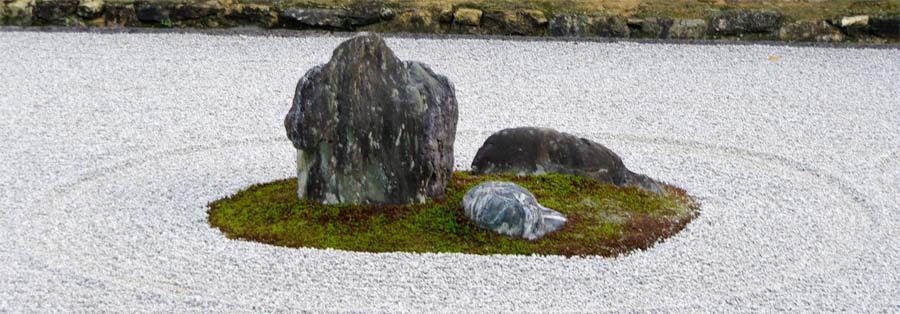
A group of 3 rocks surrounded by raked sand – Ryoan-ji
Sand and Gravel - are used in gardens that are designed to be viewed from outside and not walked on. The choice of particle size is important as it must be big enough not to blow away but small enough to raked. In Zen Gardens the raked patterns represents flowing water and contrast the solidity of the rocks. The colour is also important, white sand represents purity whilst grey, brown and blue/black sand represents tranquillity.
Raked sand representing waves.
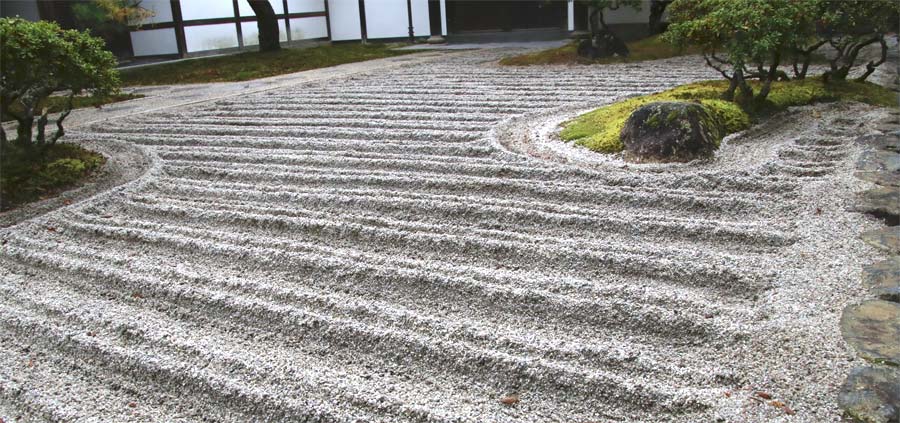
Gravel garden - Gingka-ji
Ponds, streams and waterfalls – central element represents real or mythical lakes or seas. Often carp living in the ponds add colour to the garden. 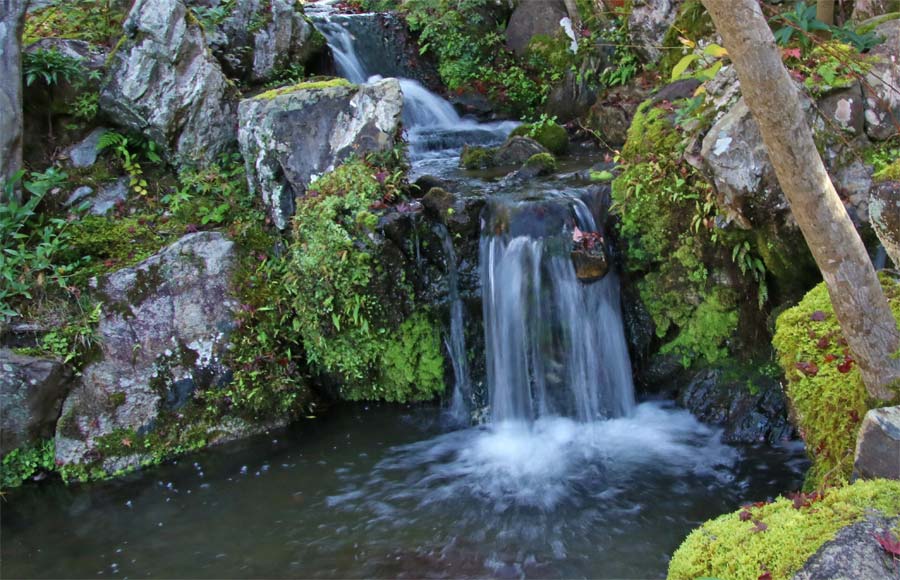
Waterfall - Isuien Gardens
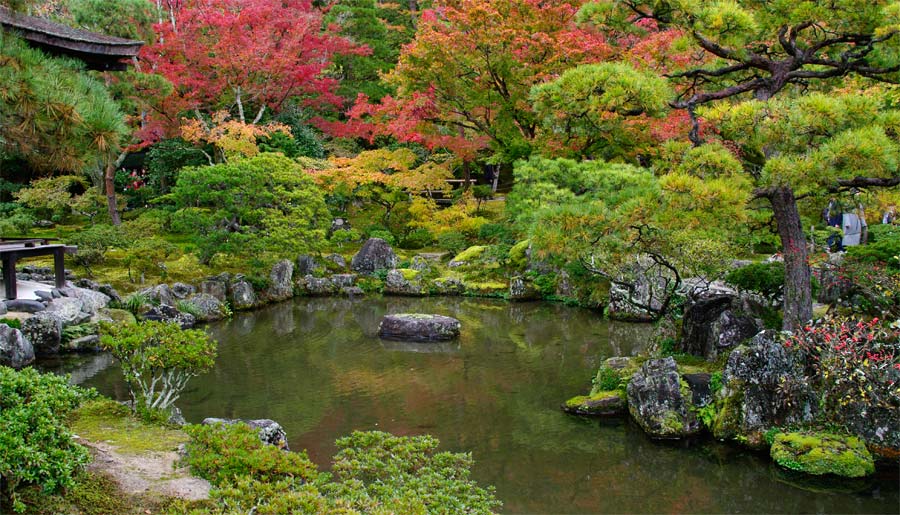 Waterfall and stream feed the pond - Gingkaku-ji
Waterfall and stream feed the pond - Gingkaku-ji
Islands – often represent real islands or have religious symbolism.
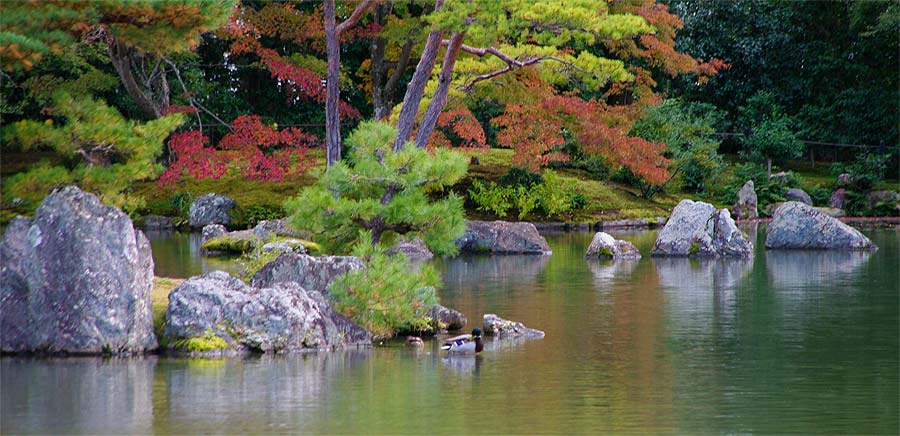
Small islands, some large enough for a tree. Kinkaku-ji
Bridges – common feature of Japanese gardens used to connect islands within the garden. They are made of stone or wood with a range of designs from very simple to extremely complex.
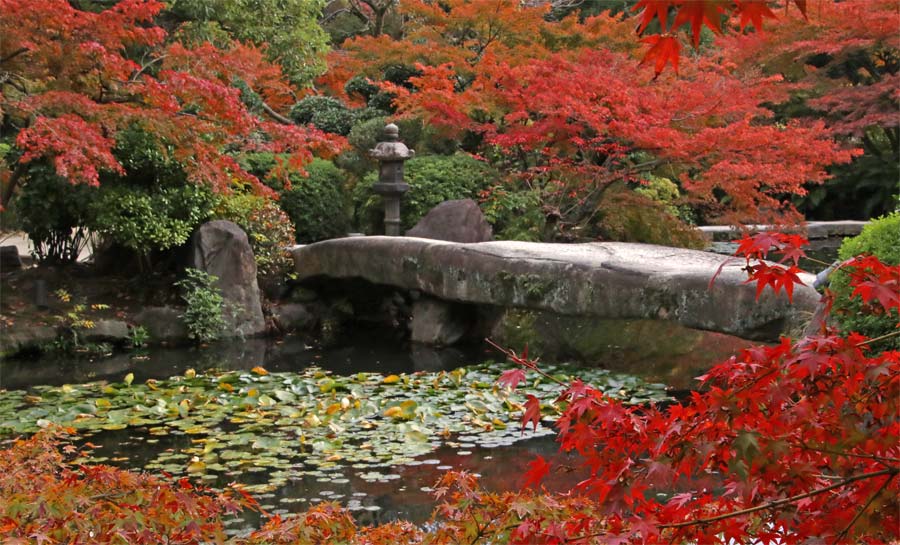
Stone bridge made from single piece of stone with a single support in centre – Private Garden Osaka
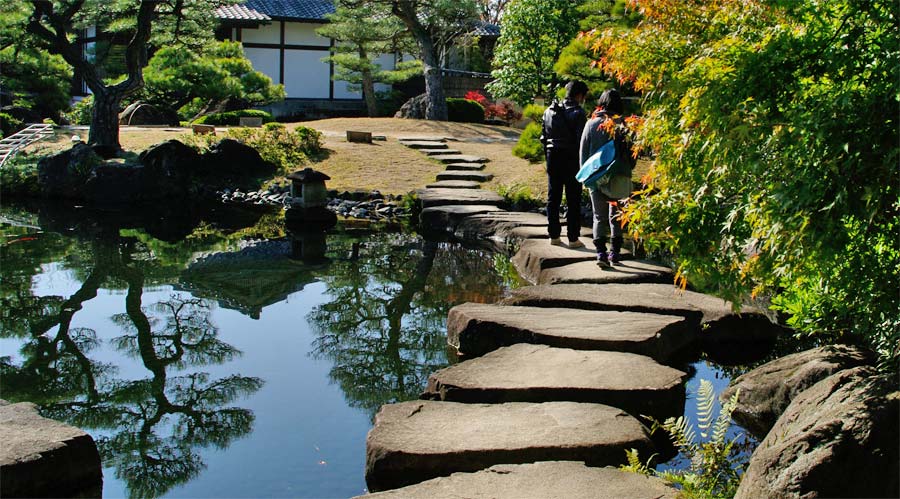
Smooth stones used as stepping stone bridge Hemi-ji – Garden of Lords Residence

Painted arched bridge – Ritsurin Gardens
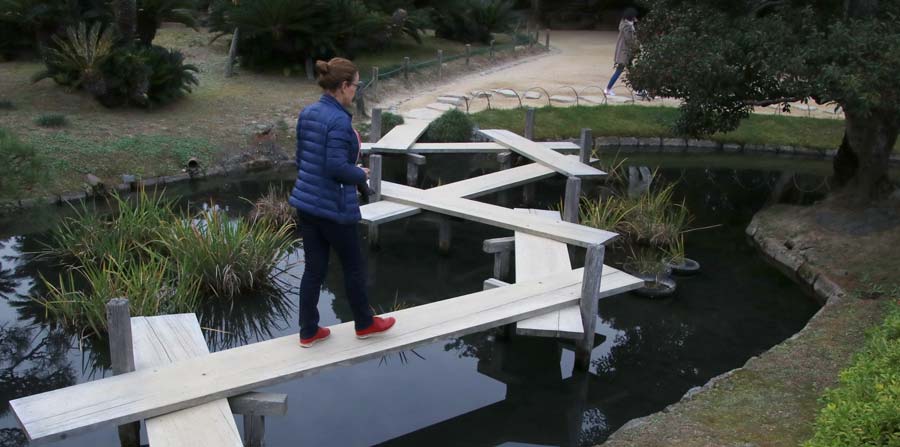
Wooden Zig-Zag Bridge – Korukuen Gardens
Lanterns - tend to be made of stone and placed in carefully chosen locations, they are used to give light and as a garden decoration.
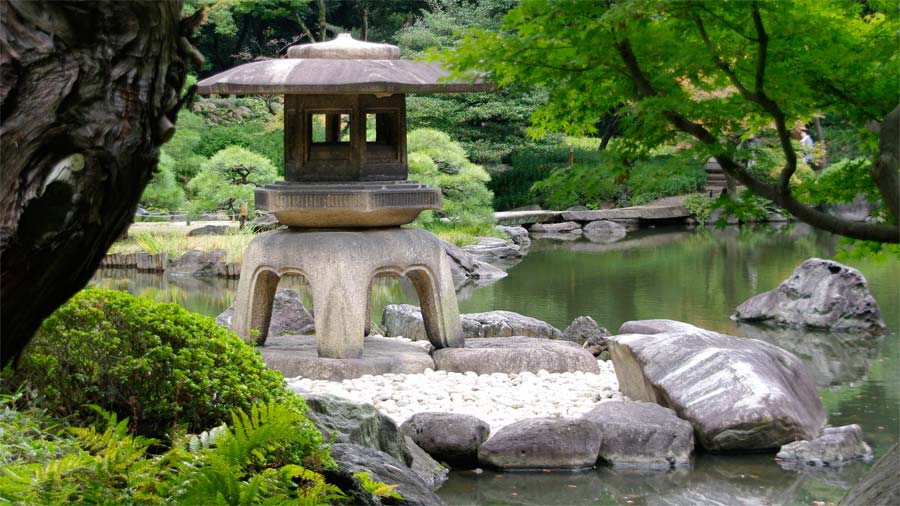
Snow Lantern – have legs and a wide roof – Kyu Furakawa Gardens Tokyo
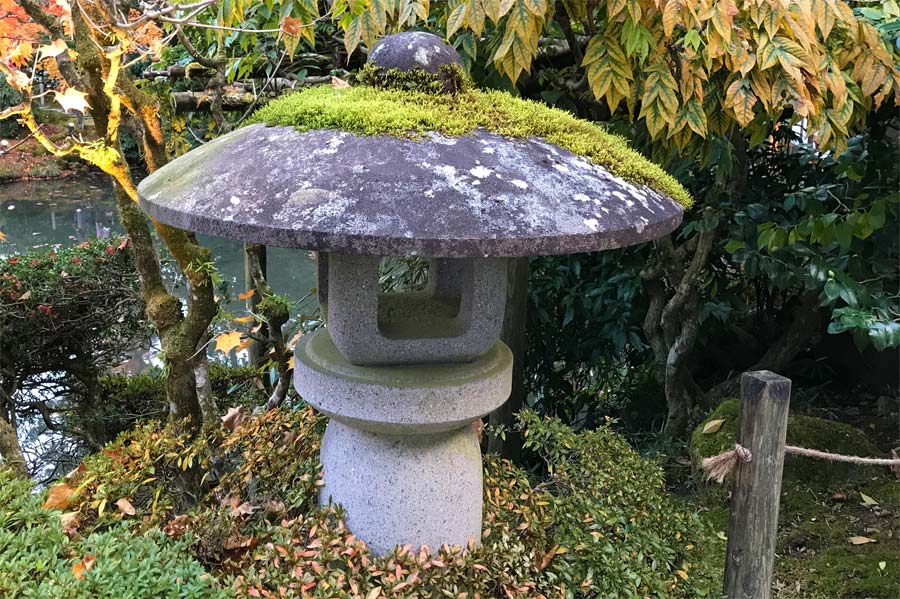
Lantern with pedestal and no base – wide roof because of snow – Shoyoeni-ji
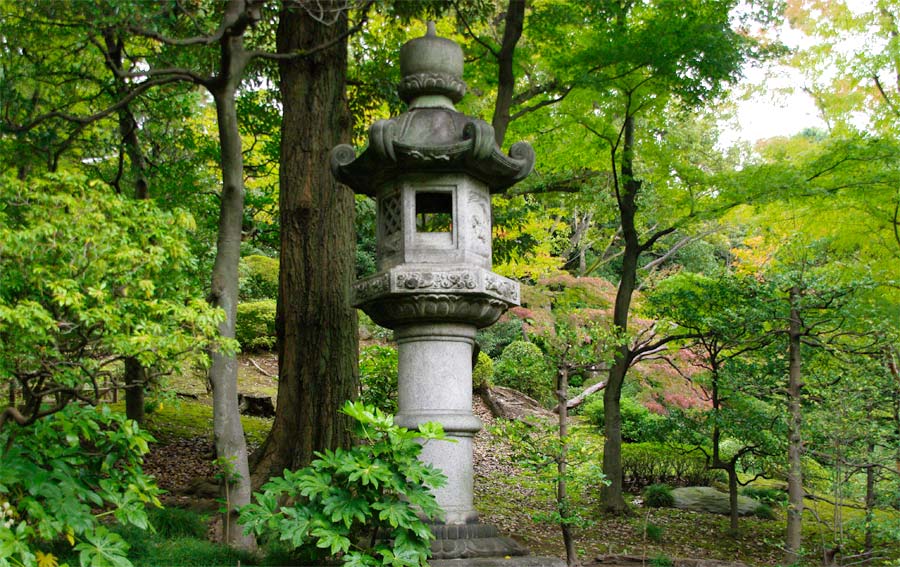
Ornate Stone lantern with pedestal and base - Kyu Furakawa Gardens Tokyo
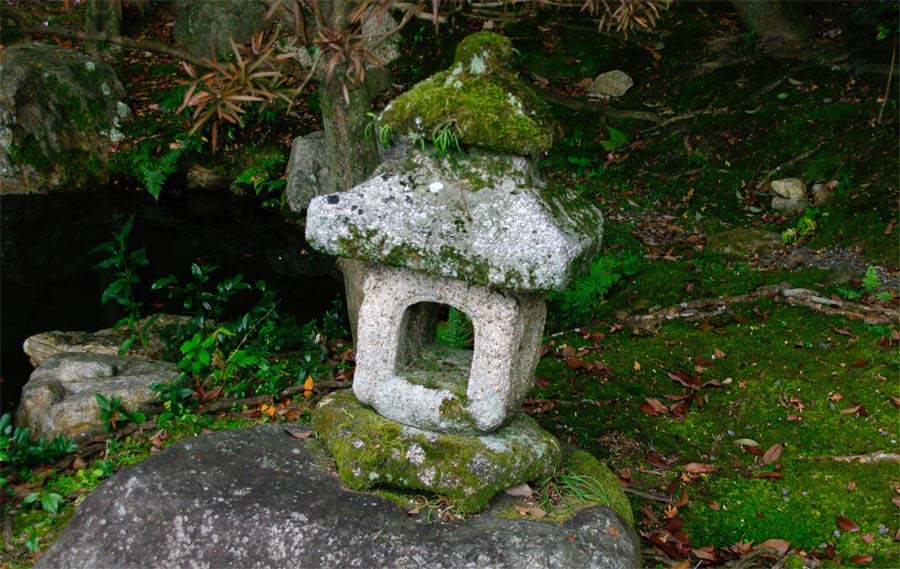
Simple stone lantern without pedestal – Tea house Kyoto
Water Basins - were originally part of tea ceremonies now they tend to be more ornamental and often placed next to a lantern.
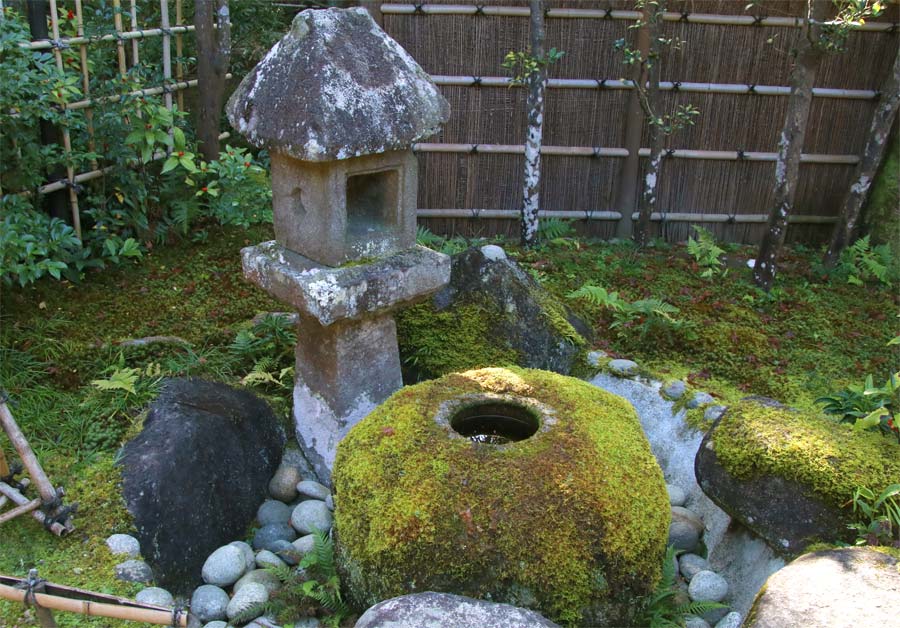
Moss covered stone waterbasin placed next to lantern Isuien Garden
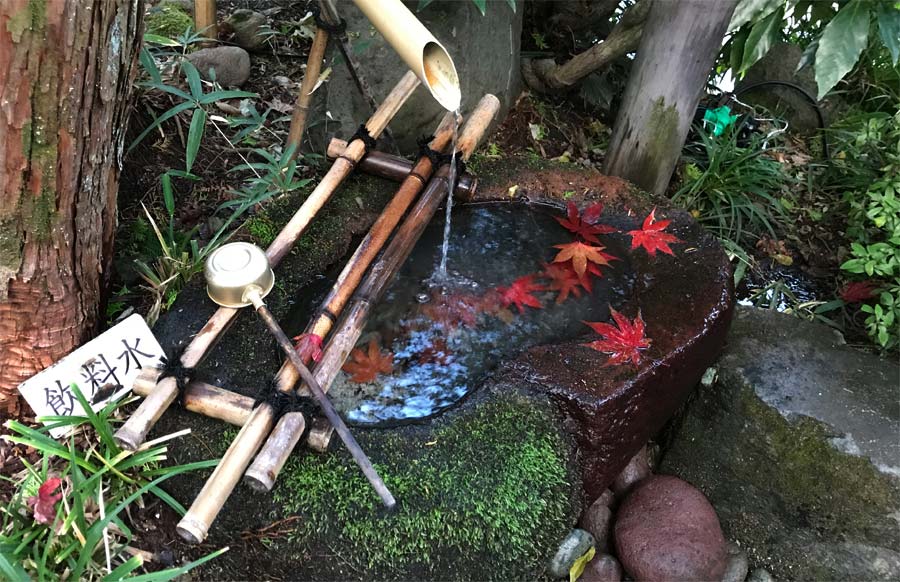
Water enters the basin through a bamboo pipe. Stone water basin Shoyoeni-ji
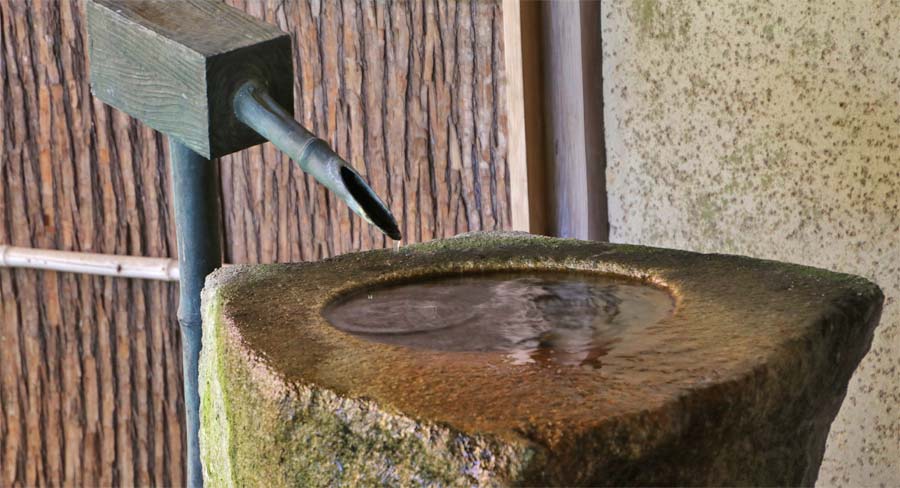
A tall stone water basin, water entering through pipe – Yoshikien Garden Nara
Paths – are an integral part of landscaped or strolling gardens. The paths take visitors to all the special parts of the garden via a carefully chosen route that hides and then reveals views. Paths are made of beaten earth, they are either left bare or covered with gravel or stones of various sizes.
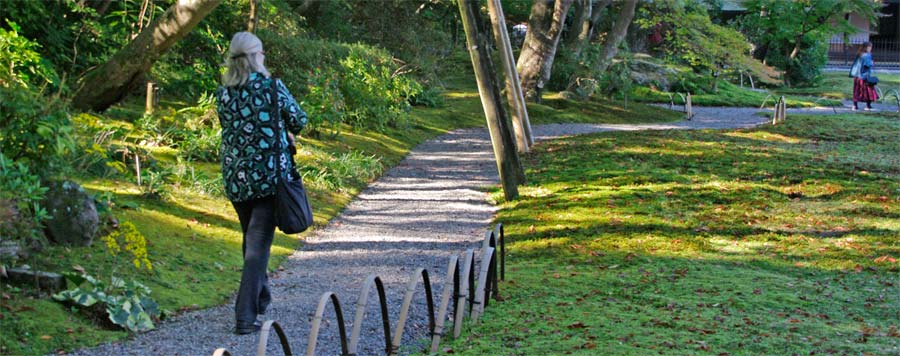
Gravel path – Yoshikien Garden
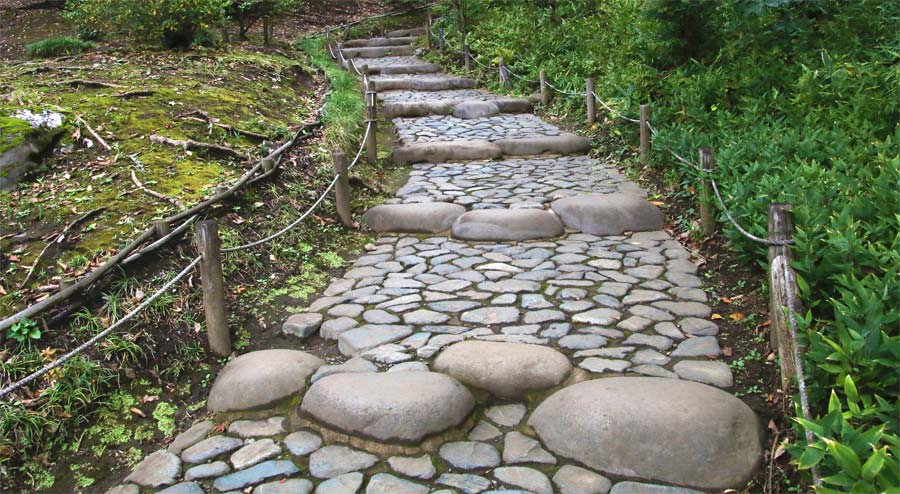 Path of mixed size smooth stones, the large stones have been used to create a small step – Kyu Furakawa Gardens Tokyo
Path of mixed size smooth stones, the large stones have been used to create a small step – Kyu Furakawa Gardens Tokyo
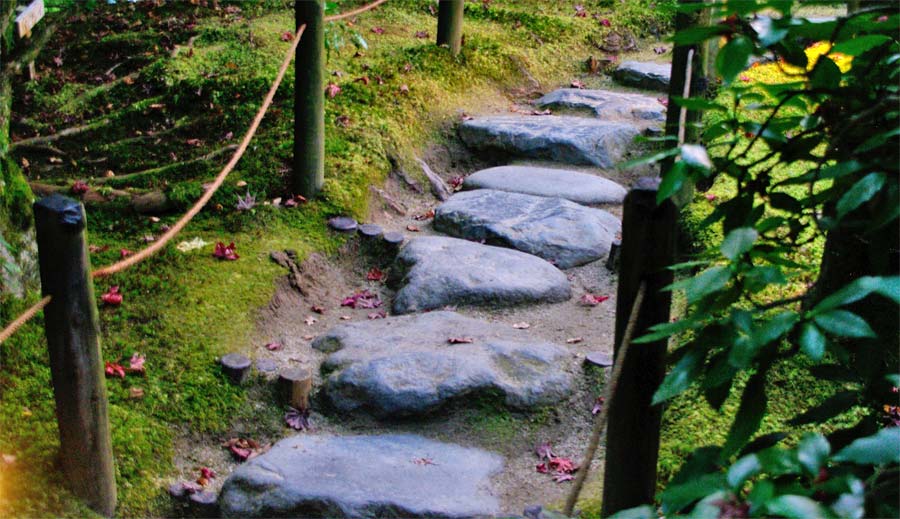
Large smooth stones placed on beaten earth – Shoyoeni Gardens
Fences and Walls – Are an important part of garden design. They not only enclose the garden but screen unsightly areas and frame features within the garden
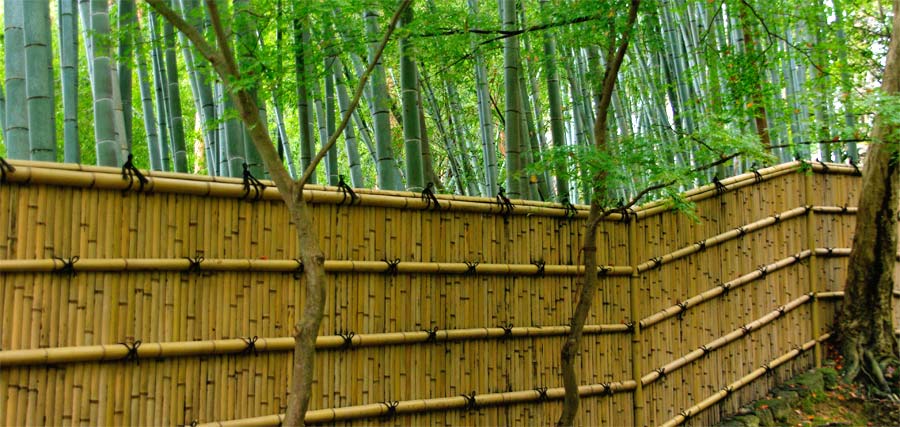
Bamboo fence divides the Bamboo Forest from Gingkaku-ji
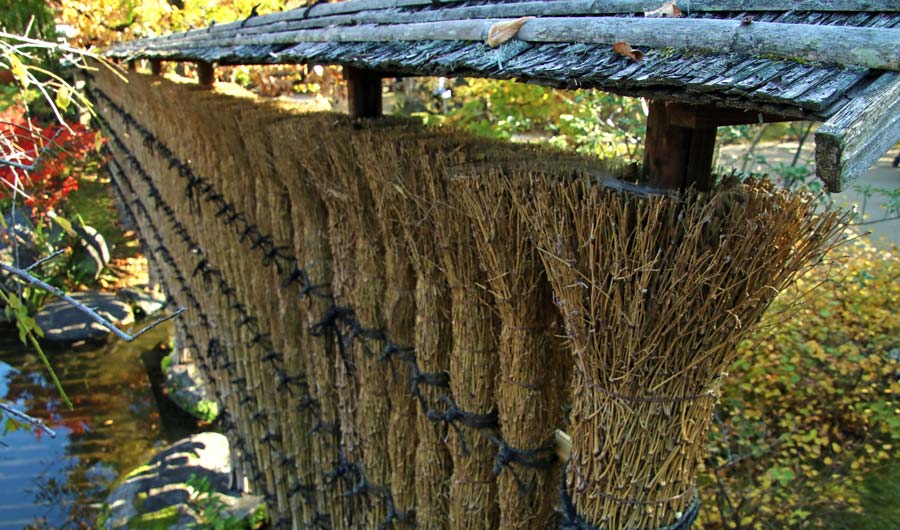
Fence of bundled young bamboo stems divides two of the nine gardens in Himeji.
Plants are also seen as symbols, they are placed carefully with space around them to emphasize individual qualities.
The evergreen plants most commonly used are Pines, Conifers and Korean Box, these are often pruned to emphasize and exaggerate their shape. Young plants are trained with wires to create the desired shape. Cloud pruning is very popular in Japan.
Japan has a high rain fall, gardens tend to be damp so that moss grows very well here. It is used as an integral part of all gardens, adding colour as it grows over rocks, buildings and stone features.
Flowering plants are chosen for their seasonal colour.
Cherry trees are chosen for their wonderful display of Spring blossom while Maples, Chrysanthemum and Miscanthus are selected for their autumn colour.
Pines and bamboos are planted to give colour and interest to the garden during the winter months.
Japanese gardens are high maintenance gardens, the gravel needs grooming every day (part of the spiritual meditation) and the shrubs and trees need pruning regularly.
To increase the illusion of the garden size, Japanese garden designers have used many tricks to alter perspectives. They plant tall bright trees with large leaves at the front and small trees with dark fine leaves at the back, this tricks the brain into thinking the distance from front to back is much further than it is.
Borrowed views use structures either natural or man-made to provide a focal point outside of the garden when viewed from inside the garden. The affect of these is to increase the depth of vision and make the garden seem much bigger than it actually is.
Miniaturisation is very popular, rocks, lakes and hills used to represent real landscapes.
Summary:
Japanese gardens are a joy to visit. They are very different to European gardens, there are no formal lines or wide borders. The paths are never straight. They take visitors on a glorious adventure with plenty of surprises, borrowed views, tranquil ponds, bubbling streams, waterfalls, trees heavy with pink blossom in spring or deep red leaves in autumn.
You will be delighted and inspired. Many even experience an inner serenity.
Enjoy your visit.